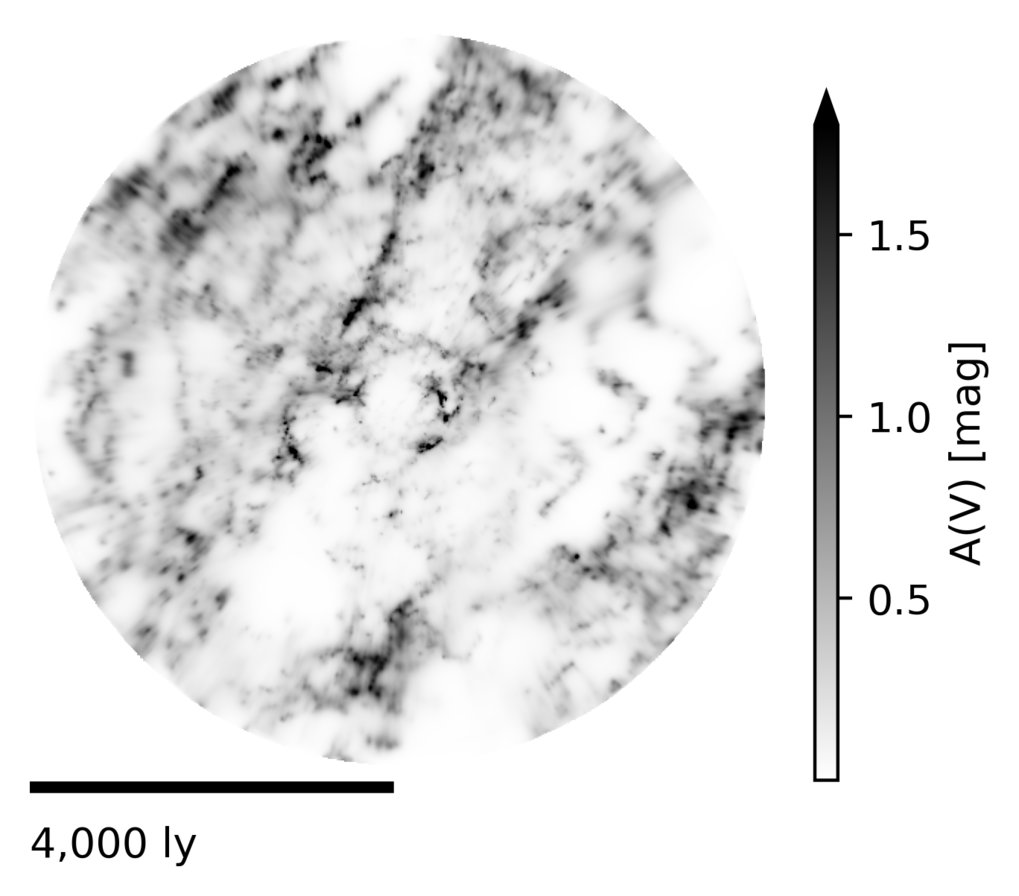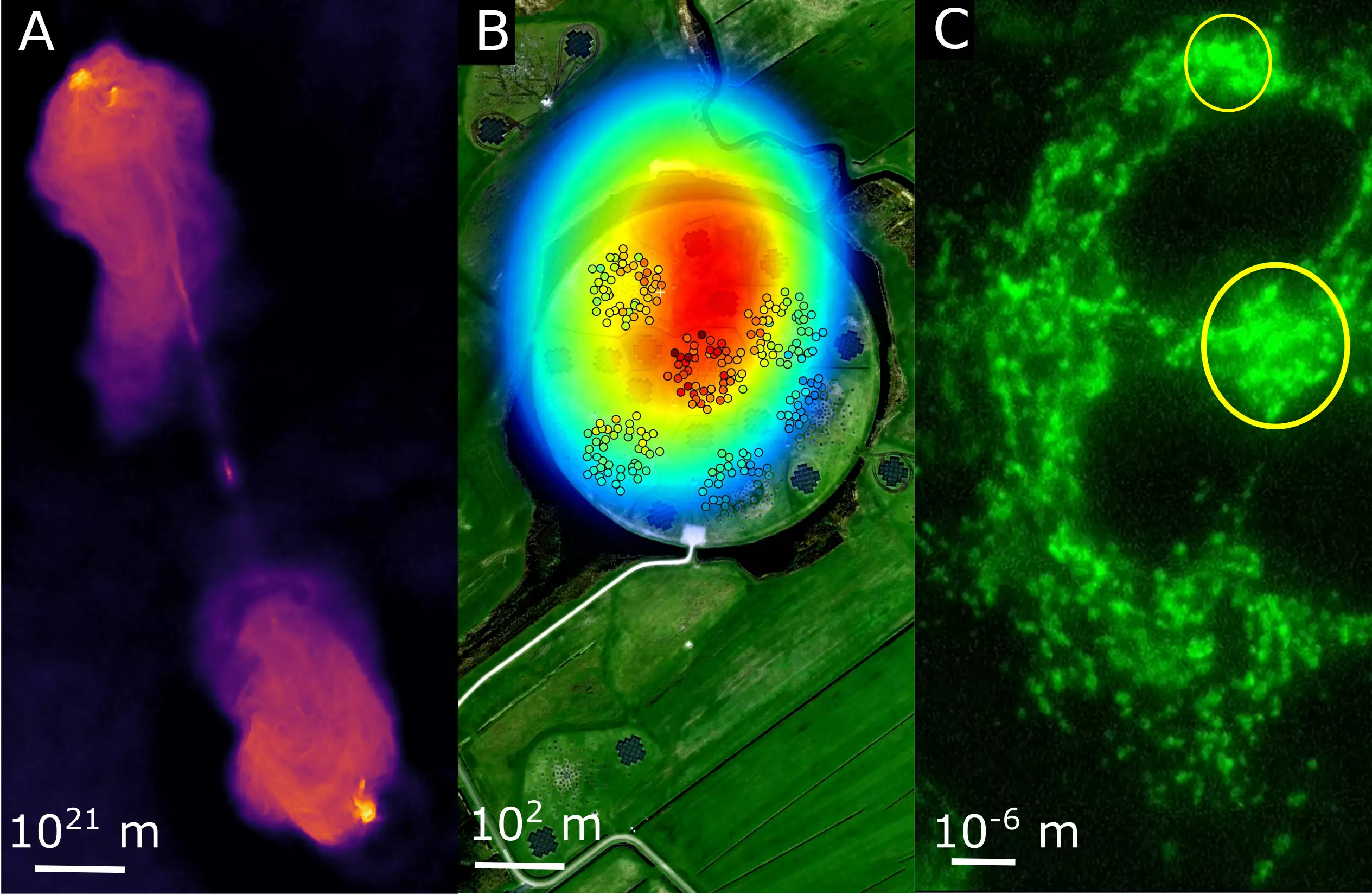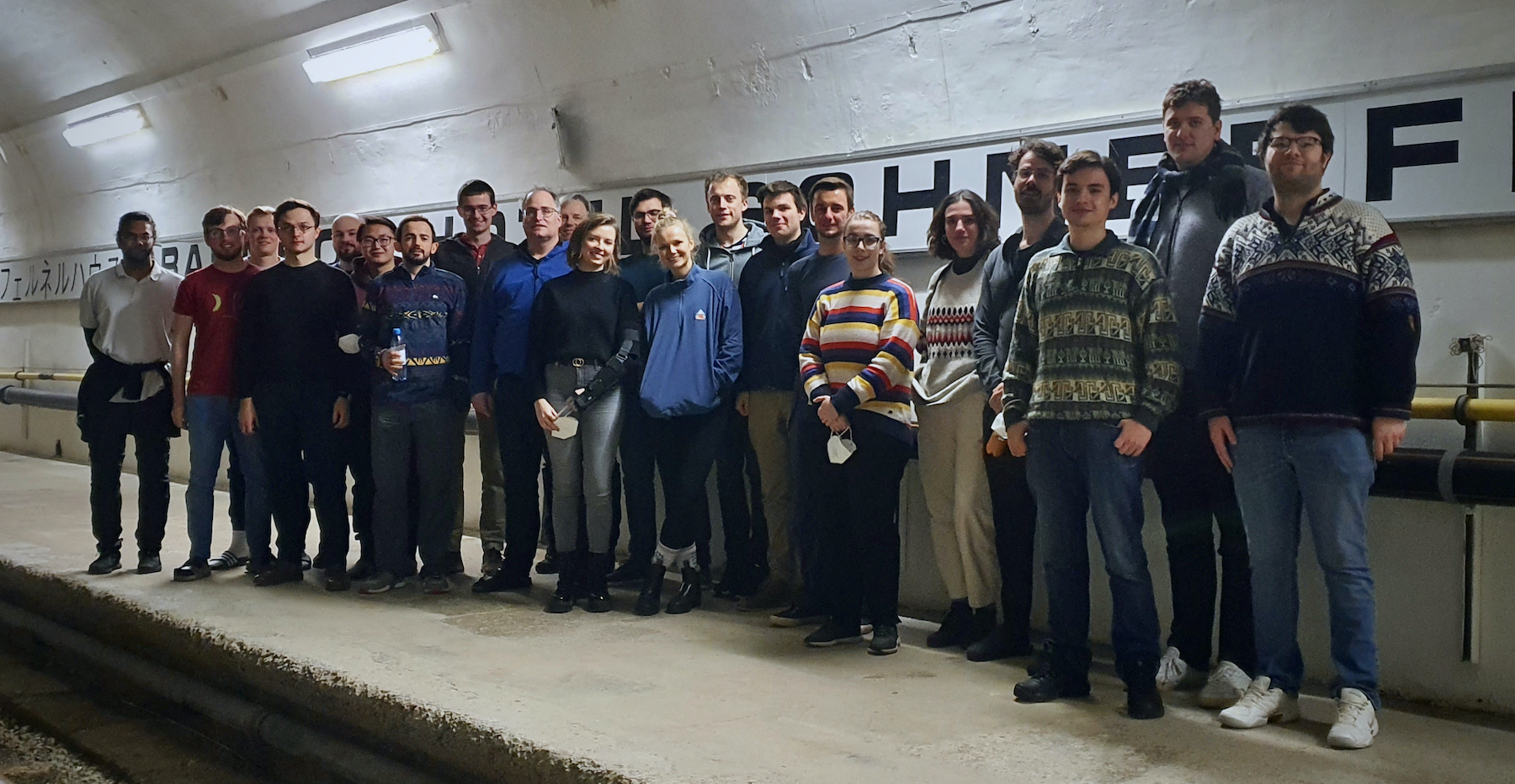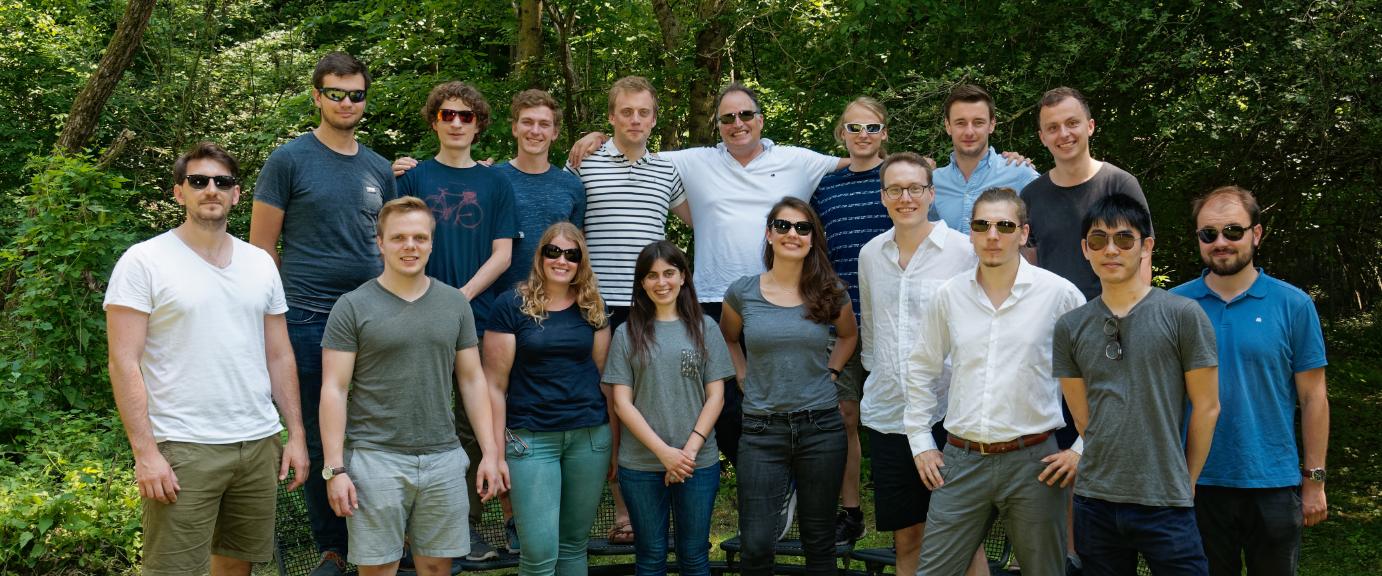
Torsten Enßlin
I am a scientist at the Max-Planck-Institut für Astrophysik (MPA), Garching (near Munich), and lecturer at the Ludwig Maximilians University, Munich in Germany. I am interested in Information Theory, especially Information Field Theory (IFT), Artificial and Other Intelligence, Cosmology, and High Energy Astrophysics.
Recent Research Highlights
A Three-Dimensional Atlas of the Milky Way

European Research Council funds scientists at MPA, RTWH Aachen, and IA-FORTH to map Galaxy in 3D
- Learn more
- Learn more
- Learn more
- Learn more
This mathematical tool could improve how fast information is shared

Researchers develop "relative attention entropy" to optimize data transmission, aiding AI learning and communication systems. (text by Andrey Feldman, image by Rene Böhmer on Unsplash)
Our Neighborhood in the Milky Way in 3D

High-resolution three-dimensional maps of the Milky Way have previously been limited to the immediate vicinity of the Sun. In a collaboration led by the Max Planck Institute for Astrophysics with researchers from Harvard, the Space Telescope Science Institute, and the University of Toronto, we were now able to build a high-resolution map of the Milky Way in 3D out to more than 4,000 light-years. The produced 3D map will be highly useful for a wide range of applications from star formation to cosmological foreground correction.
Radiation biology, radio astronomy and cosmic rays using information field theory

What do radiation biology, radio astronomy and cosmic ray measurements have in common? For one thing, radiation occurs in all of them. For another, all of these fields are explored using large-scale research facilities and require intelligent algorithms to visualize the quantities that occur in the process. In order to advance this imaging in an interdisciplinary way, the Federal Ministry of Education and Research (BMBF) is now funding the project "Information Field Theory for Experiments at Large-scale Research Facilities". Seven German universities, the Max Planck Institute for Astrophysics (MPA) and Erium GmbH, founded by former MPA students, are involved.
Manipulative communication in humans and machines

A universal sign of higher intelligence is communication. However, not all communications are well-intentioned. How can an intelligent system recognise the truthfulness of information and defend against attempts to deceive? How can a egoistic intelligence subvert such defences? What phenomena arise in the interplay of deception and defence? To answer such questions, researchers at the Max Planck Institute for Astrophysics in Garching, the University of Sydney and the Leibniz-Institut für Wissensmedien in Tübingen have studied the social interaction of artificial intelligences and observed very human behaviour.
Research
Information Field Theory
Information field theory (IFT) is information theory, the logic of reasoning under uncertainty, applied to fields. A field can be any quantity defined over some space, e.g. the air temperature over Europe, the magnetic field strength in the Milky Way, or the matter density in the Universe. IFT describes how data and knowledge can be used to infer field properties. Mathematically it is a statistical field theory and exploits many of the tools developed for such. Practically, it is a framework for signal processing and image reconstruction.
Learning Machines, Extended Logic, & Intelligence
Loosly connected research lines on machine learning, information theory, as well as artificial and other intelligence. Learning Machines better reason according to logic. If uncertainties are involved, this should be extended, probabilistic, or Bayesian logic. The same is true for any form of intelligence, whether of human, artificial, or other nature.
Galactic Cartography
Accurate maps of the Milky Way in all its spatial, spectral and other dimensions are required for precision astrophysics. Here a collection of reconstructions of various galactic components in 2D and 3D are provided, which were obtained with information field theory.
Cosmology
The temperature fluctuations in the cosmic microwave background (CMB) and the cosmic matter distribution in the large-scale structure (LSS) are both tracers of the primordial quantum fluctuations. Those are believed to have happened during the very first moments of the Universe in the inflationary epoch. CMB and LSS are therefore our primary information sources on cosmology. Their detailed studies provide us insight into the history, geometry and composition of the Universe. IFT permits us to construct optimal methods to analyse and interpret CMB and LSS data, and to image with high fidelity the cosmic structures imprinted in those data sets.
High Energy Astrophysics
The Universe is permeated by high-energy particles and magnetic fields. Charged particles with nearly the speed of light spiraling around in the magnetic fields, which themselves are bound to the cosmic plasma. The particles and fields are important ingredients of the interstellar and intergalactic media. They transport energy, they push and heat the thermal gas, and they trace violent processes in cosmic plasmas. A number of observational windows in basically all electromagnetic wavebands, ranging from the radio to the gamma ray regime, provide us with direct and indirect vision into the high energy Universe. The IFT group develops special purpose methods to better imagine relativistic particles, magnetic fields, and even to tomographically reconstruct their distributions within the Milkey Way.
Lecture on Information Theory & Information Field Theory
Imaging in astronomy, geology and medicine require intelligent methods to obtain high fidelity images from noisy, incomplete data. The theoretical and mathematical framework in which imaging and data analysis methods are derived should be information theory to which these lectures will introduce first (first 1/3 semester, suited for Bachelor and Master students, 3 ETCS). Based on this, information theory for fields will be developed, which can be used to reconstruct signals from data (remaining 2/3 semester, more targeted at Master students, 6 ETCS).
Seminar Information Theory & Information Field Theory
The seminar is intended for participants of the lecture on Information Theory (1/3 semester) & Information Field Theory (2/3 semester), the content of which will be assumed to be known by all participants. The main seminar goal is to extend the participants' knowledge beyond the material covered in the lecture, especially with respect to concrete measurement situations, imaging, and existing algorithms. A second goal is to practice presentations and open discussions.
About Me
- 2024, ERC Synergy Grant for Milky Way Atlas Project
- 2024, Head of Data Science at German Centre for Astrophysics
- 2019, Giuseppe and Vanna Cocconi of the European Physical Society as part of the Planck Collaboration
- 2018, Hochsprung Award for my information field theory lecture that lead to a start-up by students
- 2018, Gruber prize for Cosmology as part of the Planck collaboration
- since 2014, Head of the Information Field Theory Group at MPA
- 2014, Call for full Professorship on Theoretical Astroparticle Physics (W3 level, declined) Karlsruhe Institute for Technology, Germany
- since 2014, Associate Professor (Privatdozent) at Ludwig-Maximilians-University Munich, Germany
- since 2008, Planck Scientist status in the Planck Surveyor Mission (full access to proprietary data)
- 2003- 2016, Head of the MPA Planck Analysis Centre, Garching, Germany
- since 2006, Tenured position at MPA
- 2003- 2006, Tenure-track-position at MPA
- 1999- 2003, Postdoctoral Researcher Max Planck Institute for Astrophysics (MPA), Garching, Germany
- 1999, Research Associate Physics Department of University of Toronto, Canada
- 1996- 1999, PhD “summa cum laude” on “Relativistic Particles and Magnetic Fields in Clusters and Filaments of Galaxies” Rheinische Friedrich-Wilhelms-Universität Bonn & MPI for Radioastronomy, Bonn, Germany

Active Group
- Roth, Jakob (PostDoc; former PhD & Master Student; Radio Interferometric Imaging with Time and Direction Dependent Calibration)
- Eberle, Vincent (PhD Student & former Master Student; Efficient Representation of Instrument Responses)
- Guardiani, Matteo (PhD Student & former Master Student; Bayesian Multi-Object Identification and Separation for X-ray Imaging)
- Harth-Kitzerow, Johannes (PhD Student & former Master Student; Effective Description of Dynamics in Large RNA Systems)
- Jetti, Mrinal (PhD Student & former Master Student; Radio Imaging of Airshowers)
- Johnson, Vishal (PhD Student & former Master Student; Quantum and Information Theory)
- Kainz, Viktoria (PhD Student & former Master Student; Interacting Adaptive Inference Systems)
- Khan, Javeria (PhD Student; Modelling Interacting Intelligent Systems)
- Nöbauer, Anton (Master Student; Image Reconstruction in 3D Microscopy with Information Field Theory)
- Rüstig, Julian (PhD Student; "Radio Correlator, Radio Imaging,Infrared Imaging, Strong Lensing" )
- Zandinejad, Hanieh (PhD Student; Galactic Tomography of the ISM)
- Zimmermann, Robert (PhD Student; Stellar Density Reconstruction of the Milky Way)
- Ashari, Mohammadreza (Master Student; Reconstruction of the Neutrino Sky Map)
- Popp, Andreas (Master Student; Calibration and Imaging of the supernova remnant SN1006 with fast-resolve)
- Shankar, Ananya (Master Student; Component Separation of the Cosmic Microwave Background)
- Sigler, Fabian (Master Student; Imaging for Coherent X-Ray Scattering)
- Durmusbas, Ahmet (Bachelor Student; Search for Quasiperiodic Signals in Magnetar Bursts with Information Field Theory)

Alumni
- Arras, Philipp (former Postdoc & PhD Student; Radio Aperture Synthesis)
- Aschenbrenner, Tobias (Master Student; Adaptive Grids for NIFTy)
- Böhm, Vanessa (PhD Student; Gravitational lensing of the Cosmic Microwave Background)
- Baumann, Marvin (Bachelor Student; Bayesian multidimensional lightcurve reconstruction of the giant magnetar flare SGR 1806-20)
- Bell, Michael (Postdoc; Radio Astronomy)
- Butler, David (Master Student; Resolving polarised emission in radio interferometry)
- Ceccarelli, Tiberio (Master Student; Separation of diffuse components in the gamma ray sky)
- Ding, Simon (Master Student; Multi-frequency radio imaging)
- Dorn, Sebastian (PhD Student; Bayesian Inference of Early-Universe Signals; Master Student; Non-Gaussianity in the Cosmic Microwave Background)
- Dupont, Martin (Master Student; Information field dynamics for cosmic rays)
- Eberle, Christoph (Master Student; Reconstruction of the time-variable gamma-ray sky)
- Edenhofer, Gordian (PhD Student & former Master Student; 3D Dust Tomography of the Milky Way)
- Fantauzzi, Alina(Master Student; Socio-physical simulations of reputation dynamics)
- Frank, Philipp (Postdoc; former PhD & Master Student; Probabilistic Inference & Numerical Optimization)
- Frommert, Mona (PhD Student; Temperatur and Polarization of the Cosmic Microwave Background)
- Fuchs, Richard (Master Student; Multi-frequency radio imaging)
- Gashi, Fatos (Master Student; Stochastic Expectation Propagation in Information Field Theory)
- Ghaempanah, Mahsa (PhD Student; Information field theory for INTEGRAL gamma ray data)
- Giese, Morten (Master Student; Inference of the atmospheric electron density with LOFAR data)
- Gorbunov, David (Master Student; Particulate Matter Reconstructions in Munich using geoVI)
- Greiner, Maksim (PhD Student; The Galactic free electron density -- a Bayesian reconstruction / Master Student; Signal Inference in Radio Astronomy)
- Guerdi, Massin (Bachelor Student; Hamiltonian Monte Carlo)
- Haim, Philipp (Master Student; Medical imaging)
- Heggenberger, Karl (Master Student; Reputation Game Simulation)
- Hutschenreuter, Sebastian (PhD Student & Master Student; Primordial magnetism; Galactic structures)
- Jasche, Jens (PhD Student; Bayesian Methods for analyzing the large scale structure of the Universe / Master Student; On the coupling between cosmic rays and primordial gas)
- Junklewitz, Hendrik (PhD Student; Radio astronomy and information field theory)
- Kaiser, Herbert (Master Student; Cosmic Rays and primordial chemistry)
- Kalfa, Ilia (Bachelor Student; Thermodynamical characterization of interacting adaptive systems)
- Kapfer, Fabian (Master Student; Multi-frequency radio calibration)
- Kehl, Sebastian (Postdoc; Machine Learning)
- Kim, Jongseo (Master Student; Generative models for pattern formation)
- Kitaura, Francisco-Shu (PhD Student; Cosmic Cartography Bayesian Reconstruction of the Cosmological Large-Scale Structure with ARGO, an Algorithm for the Reconstruction of Galaxy-traced Over-densities)
- Knollmüller, Jakob (PhD Student & Master Student; Metric Gaussian Variational Inference, Bayesian component separation)
- Koch, Andreas (Bachelor Student; Bayesian spectral and temporal feature inspection in magnetar giant flare SGR 1806-20)
- Kostić, Andrija (Master Student; Bayesian Causal Inference and Quasi Periodic Signal analysis)
- Kostyuk, Ivan (PhD Student; Cosmic simulations with deep convolutional neural networks)
- Kuchar, Petr (Master Student; TCharacteristics of magnetic fields in galaxy clusters from Faraday rotation data REALMAF and its use on Hydra A)
- Kurthen, Max (Master Student; Causal Inference)
- Kurthen, Maximilian (Bachelor Student; Discrete spherical harmonics)
- Leike, Reimar (Postdoc, PhD Student & former Master Student; 3D maps of Galactic dust)
- Lienhard, Christoph (Master Student; Hamiltonian Monte-Carlo Sampling)
- Megas, Fotis (Bachelor Student; Distinguishing Gravitational Wave Signals by Their Correlation Structures)
- Mele, Crystal (Master Student; Multi-frequency radio imaging)
- Milosevic, Sara (Master Student; Astrophysical data analysis with variational autoencoders)
- Muench, Christian (Master Student; Mathematical foundation of Information Field Dynamics)
- Newrzella, Max (Postdoc; Machine Learning)
- Oberpriller, Johannes (Master Student; Bayesian parameter estimation of miss-specified models)
- Oppermann, Niels (PhD Student; Signal inference in Galactic astrophysics)
- Outland, David (Master Student; Bioluminescence)
- Pfrommer, Christoph (PhD Student; On the role of cosmic rays in clusters of galaxies)
- Platz, Lukas (Master Student; Spatio-spetral imaging of the Fermi gamma-ray sky)
- Porqueres, Natalia (PhD Student & Master Student; Large-scale structure reconstruction)
- Pumpe, Daniel (PhD Student & former Master Student; Towards multifrequency imaging)
- Rüstig, Julian (Master Student; Combined Inference of Single Dish and Interferometric Radio Data)
- Ramírez, Andrés (Master Student; Cosmic Ray distribution in the nearby Milky Way)
- Reeb, Nico (Master Student; Tracing luminescent organisms)
- Saverchenko, Ilya (Master Student; Interacting Galaxies - Matching Simulations to Observations)
- Selig, Marco (PhD Student; Information field theory for gamma ray astronomy / Master Student; Information field theory based high energy photon imaging)
- Senk, Gasper (Master Student; Detecting Cosmic Ray artifacts in astronomical images)
- Sraml, Matevz (Master Student; Gamma ray astronomy)
- Steininger, Theo (PhD Student; Galactic tomography)
- Stojceska, Gordana (Master Student; Statistical Sampling in Multidimensional Parameter Spaces Algorithms and Applications)
- Straub, Ann-Kathrin (Postdoc; Machine Learning)
- Streit, Silvan (Master Student; Fast representation of field covariances)
- Uhlig, Maximilian (Master Student; Cosmic ray driven Winds in Galaxies)
- Ullher, Maximilian (Bachelor Student; Eine Faradaykarte der Milchstrasse unter der Annahme approximativer Symmetrien)
- Vacca, Valentina (Postdoc; Radio astronomy)
- Vogt, Corina (PhD Student; Investigations of Faraday Rotation Maps of Extended Radio Sources in order to determine Cluster Magnetic Field Properties)
- Walkens, Andre (Master Student; Studying magnetic turbulence with radio polarimetry)
- Wandrowski, Maxim (Master Student; Denoising, Deconvolving and Decomposing the COMPTEL Gamma-Ray Sky)
- Weidinger, Carolin (Bachelor Student; Kullback-Leibler divergence in physics and information theory)
- Weig, Cornelius (Master Student; Information Field Theory applied to a spatially distorted log-normal field with Poissonian noise)
- Weingartner, Helin (Master Student; Statistische Modellierung und Rekonstruktion von diffuser Roentgenstrahlung von Galaxienhaufen)
- Westerkamp, Margret (PhD Student & former Master Student; Accelerated Bayesian Models and Large Field Reconstructions)
- Wichmann, Felix (Master Student; Advanced aperture synthesis)
- Wiethof, Florian (PhD Student; Modelling Human Cognition through Sociophysical Generative Models)
- Winderling, Lars (Master Student; On the theory calibration)
- Zacherl, Johannes (Master Student; Probabilistic Autoencoder using Fisher Information)
- Zehetner, Philipp (Master Student; Bioluminescence field reconstruction)

Meetings
Recorded Talks and Interviews
-
„Können Maschinen lügen?“
in The Peckham Talks, 26.1.2024 -
„Ein dreidimensionaler Atlas der Milchstraße“
in Wissenschaft für Jedermann, Deutsches Museum München, 18.12.2024 -
„Astrophysiker Dr. Torsten Ensslin und das Geheimnis des Multiversums“
The Peckham Talks, 15.4.2024 -
„TENET erklärt! Astrophysiker Dr. Ensslin & Professor Ariel Auslender über Nolans Film Puzzle“
Filmelei - Die Filmtalkshow, 13.1.2023 -
„Informationsfeldtheorie dort einsetzen, wo sie hilft“
Welt der Physik, 28.3.2024 -
Bayes'sche Bilderzeugung/KI
Science from Space, 27.9.2022 -
Manipulating Your Reputation
The AutoML Podcast, 30.5.2022 -
Künstliche Intelligenz kombiniert +
Q&A Session
Cafe & Kosmos (Muffatkaffee, 10.3.2020) -
Information Field Theory: from astrophysical imaging to artificial intelligence
Joint Astronomical Colloquium (ESO Garching, 13.2.2020) -
Wahrheit und Wahrscheinlichkeit in All und Alltag
Cafe & Kosmos (Muffatkaffee, Munich, 9.12.2017) -
Vom Anfang der Zeit - unser Kosmos im Mikrowellenlicht
Edgar-Lüscher-Seminar am Gymnasium Zwiesel (29.4.2017) -
Scharfer Blick zurück
HYPERRAUMTV, May 17, 2017 -
Logik trifft Wahrscheinlichkeit
HYPERRAUMTV, May 17, 2017 -
Vom Anfang der Zeit: Unser Kosmos im Mikrowellenlicht ,
Slides
Einstein Symposium 2015 (13.11.2015 Zürich) -
Information field theory
Cannadian Institute for Theoretical Astrophysics, Toronto (20.3.2015) -
Our Universe - Cosmological Results of the Planck Mission
Heidelberg Joint Astronomical Colloquium (20.1.2015) -
Unsichtbare Astronomie, Radiostrahlung, zerstrahlende Materie
Gesprächsreihe mit Raoul Schrott, BR 2011-2016 (Munich, 11.03.13)
Contact
-
Address
MPA
Karl-Schwarzschild-Str. 1
85748 Garching
Germany
Office: 228 -
Email
ensslin@mpa-garching.mpg.de -
Phone
+49 (0) 89 30000 2243
